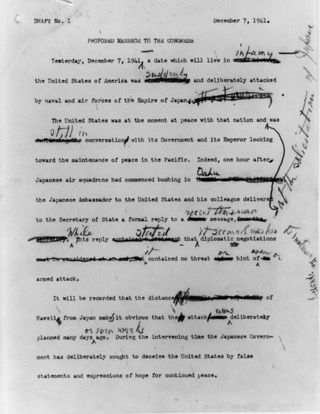Top Qs
Timeline
Chat
Perspective
Drafting (writing)
Process to create preliminary versions of a written work From Wikipedia, the free encyclopedia
Remove ads
Drafting is the process by which preliminary forms of a written work are composed.[1][2] Separate from other steps of the writing process, such as revision and editing, drafting involves the initial creation of the main content, structure, and style of a work.[3] The preliminary forms of a written work are referred to as draft documents[4] or simply drafts. Drafting is the very first step of the writing process; it gives the writer a base to expand and improve upon their work via later steps.

Drafting almost always involves rounds of cumulatively adding onto and expanding a work. The initial complete draft is known as the first draft[5] or rough draft. Typically, 'snapshots' of the draft at certain points are taken, these snapshots often being called the drafts; alternatively, the work as it currently is can be referred to as the draft. This distinction is unclear. In an essay writing environment, such as school, drafting often involves rounds of individual brainstorming, collecting evidence, and writing individual paragraphs, along with deciding on the approach to which the essay is written.[3]
Remove ads
Method
Drafting relies primarily on free writing to operate. While drafting, a writer is generally not immediately concerned with grammar or spelling but rather getting their ideas into the page in a physical form.[6] As such, a writer's first draft may not even be prose; it could potentially be a list of disconnected ideas or phrases. Writer's block is commonly considered to be a major roadblock in the drafting process.[7][4]
Remove ads
The impact of drafting on the writing process
Drafting isn't just the first step in writing. It's a major part in how writing gets better. It helps writer's play around with ideas, moving things around, and make their message known. Doing more than one draft helps improve the way something is written, making it easier to understand and more organized.[8] It also takes away the pressure to do everything right and perfect the first time, letting writers feel ok about making changes and learning as they go[9]
Remove ads
Writing by hand vs computer drafting
People can draft by hand or computer, and each way feels different. Writing by hand takes more time, which is a way to think things through or remember an idea better. Using a computer can make it easy to fix any errors and move things around. Both methods shape the way writers connect with their work.[10]
Mindset and metacognition in drafting
Writing researchers highlight the importance of metacognition, thinking about one's own thinking during the drafting process. Writer's who know who their writing is directed to are more likely to create affective drafts. Metacognitive strategies, such as reflecting on progress, asking guiding questions, and evaluating ones own's work have been found to enhance both the writing process, and the quality of the final product.[11]
Remove ads
Drafting and youth development
The drafting process plays a key role in the development of young writers. It helps students organize their ideas, gain confidence, and improve writing fluency. Studies indicate that creating and initial or zero draft can reduce writing related anxiety and support the generation of ideas, even in early stages of composition.[12]
References
Wikiwand - on
Seamless Wikipedia browsing. On steroids.
Remove ads
